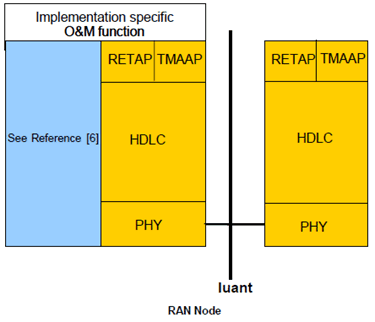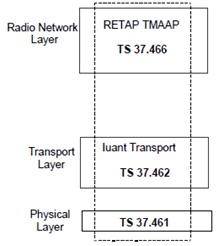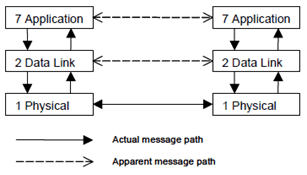TS 37.460
Iuant interface –
General Aspects and Principles
V18.0.0 (PDF)
2024/03 13 p.
V17.0.0
2022/03 13 p.
V16.0.0
2020/06 13 p.
V15.2.0
2019/12 13 p.
V14.1.0
2019/03 13 p.
V13.1.0
2019/03 13 p.
V12.1.0
2019/03 13 p.
V11.1.0
2019/03 13 p.
V10.1.0
2019/03 13 p.
V9.1.0
2019/03 13 p.
V8.2.0
2019/03 13 p.
- Rapporteur:
- Dr. Reininger, Philippe
Huawei Tech.(UK) Co. Ltd
Content for TS 37.460 Word version: 18.0.0
1 Scope p. 5
The present document is an introduction to the 3GPP TS 37.46x series of Technical Specifications that define the Iuant Interface. The Iuant interface is applicable for UTRAN, E-UTRAN and NG-RAN. In this specification UTRAN, E-UTRAN and NG-RAN are denoted as "RAN", whereas the corresponding network entities Node B, eNB, en-gNB and NG-RAN node are denoted as "RAN Node". The logical Iuant interface is an interface internal to the RAN Node and defined to reside between the implementation specific O&M function and the RET antennas and between the implementation specific O&M function and the TMA control unit function.
2 References p. 5
The following documents contain provisions which, through reference in this text, constitute provisions of the present document.
- References are either specific (identified by date of publication, edition number, version number, etc.) or non-specific.
- For a specific reference, subsequent revisions do not apply.
- For a non-specific reference, the latest version applies. In the case of a reference to a 3GPP document (including a GSM document), a non-specific reference implicitly refers to the latest version of that document in the same Release as the present document.
[1]
TS 25.401: "UTRAN Overall Description".
[2]
TS 37.461: "Iuant Interface: Layer 1".
[3]
TS 37.462: "Iuant Interface: Signalling Transport".
[4] Void
[5]
ISO/IEC 13239 (2nd Edition, March 2000): "Information Technology - Telecommunications and information exchange between systems - High-level data link control (HDLC) procedures".
[6]
TS 25.442: "UTRAN implementation-specific O&M transport".
[7]
TS 37.466: "Iuant interface: Application Part".
[8]
TR 21.905: "Vocabulary for 3GPP Specifications".
3 Abbreviations p. 5
For the purposes of the present document, the abbreviations given in TR 21.905 and the following apply. An abbreviation defined in the present document takes precedence over the definition of the same abbreviation, if any, in TR 21.905.
HDLC
High-Level Data Link Control
IP
Internet Protocol
O&M
Operations & Maintenance
OSI
Open Systems Interconnection
RET
Remote Electrical Tilting
RETAP
Remote Electrical Tilting Application Part
TMA
Tower Mounted Amplifier
TMAAP
Tower Mounted Amplifier application part
UMTS
Universal Mobile Telecommunications System
E-UTRAN
Evolved UTRAN
4 General aspects p. 6
4.1 Introduction p. 6
The Iuant interface for the control of RET antennas or TMAs is a logical part of the RAN Node as shown for a Node B in figure 9 of TS 25.401 for UTRAN. Therefore, no new RAN element for the RET antennas or TMAs and no new RAN element manager is needed. The existing Implementation Specific O&M transport (see TS 25.442 for UMTS) is used for the connection between the RET antennas or TMAs control unit and the Node B element manager.
The Iuant interface between the Implementation Specific O&M function and the RET antenna control unit function is specified in detail in the specifications for layer 1, signalling transport and RET application part (TS 37.461, TS 37.462, TS 37.466).
4.2 Iuant interface general principles p. 6
The Iuant interface for the RET antenna control is based on a three-layer protocol model. The three-layer model is a compact form of the OSI seven-layer reference model and includes only layers 1, 2 and 7:
- The Physical Layer (Layer 1) defines the signalling levels and basic data characteristics including the data rates;
- The Data Link Layer (Layer 2) for the Signalling Transport uses a specific class of the HDLC standard as defined in ISO/IEC 13239 [5];
- The Application Layer (Layer 7) defines the data payload format and the required command set. This layer is called the "Iuant: Application Part".
4.3 Iuant interface specification objectives p. 6
The Iuant interface specifications shall facilitate the following:
- Controlling the tilting of RET antennas remotely from the O&M Network and locally from the Node B;
- Indicating of TMA alarms and optionally controlling the gain of TMAs remotely from the O&M Network and locally from the Node B;
- Interfacing a mix of RET antennas, TMAs and RAN Node from different vendors;
- Providing RET or TMAs functionality accompanied by an appropriate set of signalling commands and control parameters;
- Support of error and alarm handling.
4.4 Iuant interface characteristics p. 6
The Iuant interface has a protocol structure as shown below in Figure 4.4.1.

As the Iuant and the Implementation Specific O&M are different interfaces with e.g. different addressing schemes a mediation function is needed. This mediation function uses on one side a protocol that uses the implementation specific O&M bearer (e.g. IP) and on the other side the Iuant protocol.
5 Functions of the Iuant interface protocols p. 7
5.1 Physical layer functions p. 7
The physical layer provides a multi drop broadcast link between the primary device (RAN Node) and all secondary devices (RET antennas or TMAs). Any message transmitted will be received by all other devices. If two devices transmit at the same time, their messages will be garbled.
The connection requires a half duplex communication, which requires an appropriate scheme for the timing and access control of the connection.
5.2 Data link layer functions p. 7
The data link layer provides:
- A data packet communication format;
- An addressing scheme;
- A relationship whereby the primary device controls the half duplex timing;
- A message checksum scheme to protect from transmission errors;
-
A message sequence numbering scheme which protects layer 7 from:
- Duplicated messages;
- Deleted messages;
- Receiving messages in the wrong order.
- A flow control mechanism protecting each device from being overrun by messages.
5.3 Application layer functions p. 8
The list of functions on the Iuant interface is the following:
- Control of RET antennas;
- Application software and configuration data download;
- Alarm Reporting;
- Operator specific data storage;
- Control of Tower Mounted Amplifiers (TMAs).
5.3.1 Control of RET antennas p. 8
A RET device provides means to adjust the electrical tilt of one or multiple antennas. The set of procedures to control RET antennas provides means to control the electrical tilt of one or more RET antennas remotely. The procedures are defined in TS 37.466.
5.3.2 Application software and configuration data download p. 8
The interface provides means for downloading new application software and configuration data to a secondary device.
The support of application software download to a secondary device is optional. If a secondary device supports application software download, it shall reset itself and start running the new application software automatically after the completed download. Further details on the software download procedure (e.g. the different states of the secondary device and the supported elementary procedures in these states) are described in subclause 6.1 of TS 37.466.
5.3.3 Alarm reporting p. 8
The secondary device reports every change in error status after subscription for alarm reporting by transmitting alarm messages to the primary device. Alarm information can also be interrogated in the application layer.
5.3.4 Operator specific data storage p. 8
The secondary device provides means for storage of operator specific data, e.g. inventory information.
5.3.5 Control of Tower Mounted Amplifiers (TMAs) p. 8
The TMA device provides means to indicate alarms and optionally to adjust the gain of TMAs. The set of procedures to control TMAs are defined in TS 37.466.
6 Other Iuant interface specifications p. 9
6.1 Iuant interface: Layer 1 (TS 37.461) p. 9
TS 37.461 specifies the standards allowed for implementation of Layer 1 (physical layer) on the Iuant interface.
6.2 Iuant interface: Signalling Transport (TS 37.462) p. 9
TS 37.462 specifies the signalling transport related to RETAP and TMAAP signalling to be used across the Iuant interface.
6.3 Void
6.4 Summary of Iuant interface Technical Specifications p. 9
The relationship between the technical specifications that define the Iuant interface is shown in Figure 6.4.1.

6.5 Iuant interface: Application part specification (TS 37.466) p. 9
TS 37.466 specifies protocols for application part to be used over the Iuant interface.
A OSI model overview p. 10

Figure A.1 shows the relevant OSI model layers and the communication paths between the primary and secondary device.
The two important aspects of the OSI model are:
- It defines a layered structure for the communication software;
- It provides each layer with an apparent direct link to the same layer at the other device.
- Layer 2 at the first device passes the message down to Layer 1;
- Layer 1 transmits the message across the physical connection (for instance a wire) to layer 1 at the second device;
- Layer 1 at the second device passes the message up to Layer 2 at the second device.
- Layer 7 at the first device passes the message down to Layer 2;
- Layer 2 at the first device passes the message down to Layer 1;
- Layer 1 transmits the message across the physical connection (for instance a wire) to layer 1 at the second device;
- Layer 1 at the second device passes the message up to Layer 2 at the second device;
- Layer 2 at the second device passes the message up to Layer 7 at the second device.